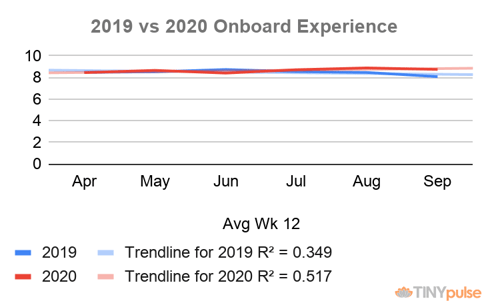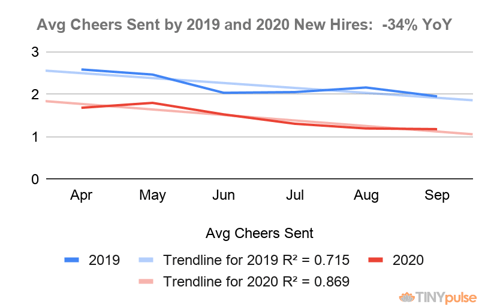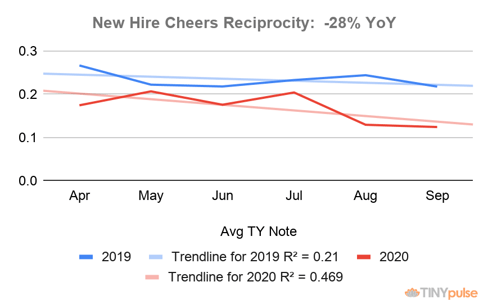New Hires Suffering in Silence: Two Key Ingredients Missing from Remote Onboarding Programs
-1.png?width=488&name=Untitled%20design%20(1)-1.png)
Employees who were hired during the COVID-19 pandemic are struggling to get connected in the social fabric and culture of organizations in ways that may not be easily observed. This cohort is providing 34% less peer recognition than their counterparts from the previous year. What’s more, they are 20% less likely to acknowledge company values by tagging values to the recognition they do provide.
Dr. Brooks Holtom and Dr. Elora Voyles partnered to uncover these insights after analyzing TINYpulse data from new hires, who started in April–September 2019 versus April–September 2020.
Surprisingly, if you survey these 2020 new hires, they’ll self report doing just as well as the previous year’s new hires. But their behaviors betray the survey results.
“I’ve also found it more difficult to successfully orient new hires to their role remotely,” explains Rolf Bax, CHRO of Resume.io. “I think the biggest challenge of remote onboarding compared to traditional in-person methods is that it is more difficult for a new hire to get a feel for an organization's culture and its people from behind a screen.”
Fortunately, our research shows this unobserved challenge can be overcome by placing management attention on your organization’s mission and values and investing in a mentoring program.
Rapidly adapting to remote work
When COVID-19 hit corporate America, many organizations had to learn how to work remotely, and that included onboarding new hires in a remote manner as well.
We analyzed over 100 organizations that onboarded more than 500 new hires between April and September 2019 and compared that data with the same organizations that onboarded nearly 500 new hires between April and September 2020 to see how their attitudes and behaviors differed.
According to our data, 2019 and 2020 new hires rated their overall onboarding experience almost identically, with 2020 being about 2% higher on average. Most leaders would probably take this as a positive sign that they’ve successfully adapted their new hire onboarding process to Zoom, Teams, and other remote methods.

Unfortunately, it turns out that what these new hires are reporting in surveys is much different than their actual behavior. This was measured via their engagement with a simple online recognition platform called Cheers for Peers that enables both 2019 and 2020 cohorts of new hires to provide peer-to-peer recognition to their new colleagues.
First, despite reporting identical high levels of satisfaction with their onboarding process, the 2020 class in a post-COVID-19 remote world gave 34% less recognition to their colleagues compared to their 2019 counterparts. This is consistent month over month from April through September.
This could be related to the lack of casual collisions that the physical workplace offers.
“With no welcome lunch or coffee breaks, it is difficult to have small chats on non-work items,” says Kim Chan, CEO of DocPro. “This is the most difficult part.”

Second, when sending a Cheers for Peers, these new hires can also easily click to tag their Cheers with a company value that is predefined by the organization.
In April and May, the rate of recognition tagged with a company value was very similar. But then from June to September, the rate decreased significantly in the remote environment of 2020. In fact, September year-over-year data saw an alarming 20% decline in this activity. The reduction in tagged values shows that employees are decreasingly identifying with company values, which can be a sign of lower engagement and commitment.

Third, a positive sign of a robust onboarding process is that new hires and existing employees begin building mutual bonds with each other. One way this is represented is via reciprocity of recognition. The data highlights that new hires who gave others recognition in 2020 saw a 28% decline in receiving a thank-you note from the recipient compared to the 2019 new hire cohort.
“New hires will not develop the habit of working in a team because they will be trained to work by themselves to comply with the requirements of remote working,” explains Michelle Devani, founder of Lovedevani. “This inhibits them from building relationships and connections like they used to pre-pandemic.”

COVID-19 has materially altered how business leaders think about the future of work. Undoubtedly, there will be more remote-only, remote-first, and hybrid models instead of business as usual as we move into the future.
That said, this does not mean that new hires need to have a less-than-stellar onboarding experience that manifests both attitudinally and — more importantly — behaviorally. Our research shows two investments that companies can make to significantly improve their remote onboarding experience.

-
Emphasizing organizational values
Many organizations highlight their unique values on their websites and throughout the interview process. Most also share their company values during onboarding. But few continue to reinforce their values after that.
Our research reveals that employees’ identification with organizational values is associated with increased frequency of recognition given to their peers. Emphasizing organizational values can positively impact the company’s reputation and increase employee loyalty.
Simple methods to reinforce company values include:
- Reiterating values during all-hands meetings and emphasizing the real-life experiences of people who have demonstrated those values
- Citing examples of values in action in company communications (e.g., newsletters)
- Including values as tags that can be added to recognition (Cheers)
- Providing rewards to individuals who live out company values externally to customers and internally to colleagues
-
Creating a mentoring program
Mentoring has positive effects for performance, interpersonal relations, career success and many other work-relevant outcomes.
Relatedly, employees who feel mentored and coached in their organization send more recognition to their colleagues. This is even more important for new hires who are onboarded remotely.
“A major aspect of onboarding new hires is integrating them into the organization’s culture, and building a strong foundation for a long-term relationship with the employee.” says Joseph Puglise, Senior Director of Executive Search & Recruiting at JMJ Phillip. He goes on to say that, “this isn’t impossible in a remote work setting, but it requires concerted effort on behalf of team members and leadership to reach out and connect.” One structured way to reach and connect is via a mentoring program.
Investing in a formal or informal mentoring program helps new hires ramp up to speed not only on the productivity front but also on the interpersonal teammate front. This can even start casually with buddy programs and evolve to more formal inter-department networking to build more bridges for new hires.
Dr. Elora Voyles adds, “An e-mentor can provide support and a personal connection for new hires in the organization. E-mentoring is cost-effective, but it will require some investment to find and match willing mentors to mentees. Mentoring relationships will need continued support and check-ins to ensure that the mentoring program is a positive and worthwhile experience for everyone involved.”
Anyway you look at it, 2020 was a trying year — especially for HR leaders who had to navigate COVID-19, employee wellness concerns, rapidly adjusting to working from home, hiring talent remotely, and onboarding them remotely. Despite their best efforts, 2020 new hires are not engaging with their colleagues and values the same way as just one year prior due to working from home for most.
Fortunately, this tide can be turned by reinforcing company values and investing in mentoring programs.
Share this
You May Also Like
These Related Stories

Weighing the Hidden Costs and Benefits of WFH — Nadella Is Asking The Right Questions

How The Sexes Differ On Diversity, Equity, & Inclusion


.png?width=534&height=632&name=blog%20ad%20(1).png)
